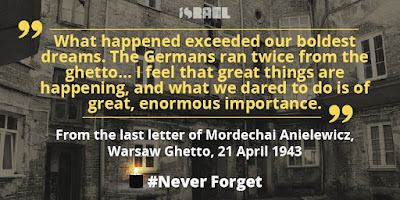Seventy years ago, modern Jewish history began when the Jews of the Warsaw Ghetto rose up to combat their tormentors.
Yes, Abq Jew is aware that this statement oversimplifies and overlooks. The website of the United States Holocaust Memorial Museum tells us:
Between 1941 and 1943, underground resistance movements developed in approximately 100 ghettos in Nazi-occupied eastern Europe (about one-fourth of all ghettos), especially in Poland, Lithuania, Belorussia, and the Ukraine. Their main goals were to organize uprisings, break out of the ghettos, and join partisan units in the fight against the Germans.Jews fought back, both spiritually and physically. Jews fought back, in camps and in ghettos. Nevertheless:
The Warsaw ghetto uprising in the spring of 1943 was the largest single revolt by Jews. Hundreds of Jews fought the Germans and their auxiliaries in the streets of the ghetto. Thousands of Jews refused to obey German orders to report to an assembly point for deportation. In the end the Nazis burned the ghetto to the ground to force the Jews out. Although they knew defeat was certain, Jews in the ghetto fought desperately and valiantly.
rememberrememberrememberrememberrememberrememberrememberrememberremember
Since the 12 century, there has been a saying:
From Moses to Moses, there was none like Moses.
Which is to say: from Moshe Rabbenu until Maimonides (Rabbi Moshe ben Maimon), there was none like Moshe.
 Abq Jew would like to propose a new saying:
Abq Jew would like to propose a new saying:
From Mordechai to Mordechai,
there was none like Mordechai.
Which is to say: from Mordechai the Jew in Shushan the Capital until Mordechai Anielewicz the Jew in Warsaw the Capital, there was none like Mordechai.
Mordechai Anielewicz (1919 – 8 May 1943) was the leader of Żydowska Organizacja Bojowa (Jewish Combat Organization), also known as ŻOB, during the Warsaw Ghetto Uprising.
Wikipedia further states:
Anielewicz was instrumental in the first act of the Warsaw Ghetto Uprising, preventing the majority of a second wave of Jews from being deported to extermination camps. This initial incident of armed resistance was a prelude to the Warsaw Ghetto Uprising that commenced on 19 April.The Midrash tells us:
Though there were no surviving eyewitnesses, it is assumed that he took his own life on 8 May 1943, along with his girlfriend and many of his staff, in a mass suicide at the surrounded ŻOB command post at 18 Miła Street. His body was never found and it is generally believed that it was carried off to nearby crematoria along with those of all the other Jewish dead; nevertheless, the inscription on the obelisk at the site of the Miła 18 bunker states that he is buried there.
Mordechai, in his generation, was equal to Moshe in his.
rememberrememberrememberrememberrememberrememberrememberrememberremember
Just a few kilometers south of Ashkelon (Abq Jew's former home in the Land of Israel), just north of the Gaza Strip, stands Kibbutz Yad Mordechai.
 |
| Monument to Mordechai Anielewicz at Kibbutz Yad Mordechai, by Nathan Rapoport |
Yad Mordechai - named, of course, in honor of Mordechai Anielewicz - is often skipped over on Holy Land tours. In Jerusalem, tourists and worshipers visit Yad VaShem. In the north, they often visit Kibbutz Lochmei HaGetaot (Ghetto Fighters).
But Yad Mordechai holds a special place in Jewish and Israeli history - because of the bravery shown there during a few days in May 1948. Wikipedia tells us:
The Battle of Yad Mordechai was fought between Egypt and Israel in the 1948 Arab-Israeli War, at the Israeli kibbutz of Yad Mordechai. The Egyptians attacked the communal village several times throughout May 19 and May 20, but failed to capture it.
A final attack was launched on May 23, in which the Egyptians succeeded in capturing part of Yad Mordechai, following which the Israeli defenders withdrew. Yad Mordechai finally fell to the Egyptians on May 24 after hours of bombardment of the vacated kibbutz.
The kibbutz residents, aided by twenty Haganah fighters, imposed a five-day delay on the Egyptians. This gave Israeli forces time to prepare for the Egyptians' northward advance, and they succeeded in halting the Egyptian advance at Ad Halom less than a week later.
rememberrememberrememberrememberrememberrememberrememberrememberremember
In five years, the Jewish People moved from the Warsaw Ghetto to Yad Mordechai; from the doomed Uprising to the victorious War of Independence. In just five years.
The Forward reports (via Haaretz):
Polish President Bronisław Komorowski [last] week announced his sponsorship of events commemorating the 70th anniversary of the Warsaw Ghetto Uprising and the Nazis’ destruction of Warsaw’s Great Synagogue.
מי ימלל גבורות ישׂראל



No comments:
Post a Comment